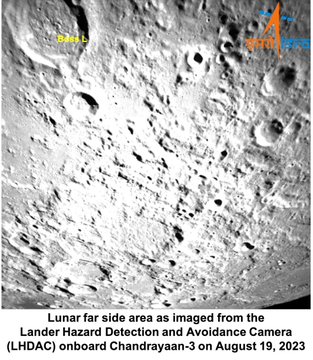The Indian Space Research Organization (ISRO) on Monday released fresh pictures of the Vikram lander of the Chandrayaan 3 mission, determining the landing site on the moon.
The Indian Space Research Organisation (ISRO) on Monday released pictures of the Vikram lander determining the landing site – two days before the landing.
In a post shared on microblogging site X, two days before the landing, the ISRO shared images of the moon’s far side area captured by the Lander Hazard Detection and Avoidance Camera (LHDAC).
“This camera that assists in locating a safe landing area — without boulders or deep trenches — during the descent,” the ISRO posted.
The camera was developed at the Space Applications Centre (SAC) under ISRO’s guidance.
Dr K Rajeev, Director of the Space Physics Laboratory during a recent briefing emphasized the immense importance of the forthcoming stages, particularly the powered descent, navigation, and the slow descent to the lunar surface. “That’s the most crucial phase,” he stated.
Dr Rajeev also shared news about the mission’s components, highlighting the presence of a lander and a rover. The rover, currently nestled within the lander, houses two key payloads: The Alpha Particle Excite Spectrometer (APES) and Laser-Induced Breakdown Spectroscopy (LIPSE).
These instruments are designed to measure surface constituents, providing vital information about lunar minerals and materials such as magnesium, aluminium, iron, and more.
Within the lander itself, four essential payloads are at work. Two originate from the Space Physics Laboratory at the Sarabhai Space Center, one from URSC, and the fourth is a retroreflector primarily aimed at moon-to-earth ranging.
Among these payloads, a seismograph will measure lunar seismic activities, offering valuable insights into the moon’s geological processes.
On the physics side, Rambha LP (Lemur Pro) will study the plasma density in the lunar atmosphere, which, plays a significant role.
Additionally, ChaSTE (Chandra’s Surface Thermophysical Experiment) is tasked with measuring the thermal conductivity of the lunar regolith, the moon’s top layer. This data is vital for potential future space base construction.
ES Padma Kumar, the Director of ISRO’s Internal System Unit (IISU), shared details regarding Chandrayaan 3’s pre-landing phase.
“The spacecraft is currently in an orbit around 110 x 25 km, and from this point, it will embark on its descent, which is anticipated to last approximately 15 to 16 minutes. The descent is set to commence on Wednesday, according to ISRO’s plan”, said Kumar.
Kumar emphasized the significance of adhering to this trajectory for a successful descent.
As ISRO inches closer to the lunar surface, anticipation among scientists, space enthusiasts, and the global community continue to mount.






















